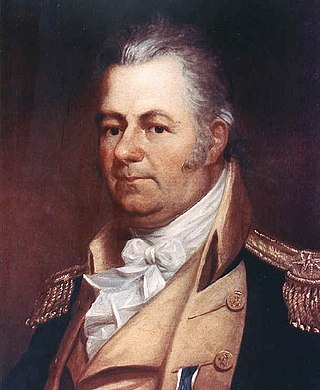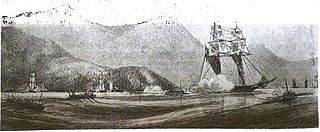
The Quasi-War was an undeclared naval war fought from 1798 to 1800 between the United States and the French First Republic, primarily in the Caribbean and off the East Coast of the United States.

Thomas Truxtun was an American naval officer after the Revolutionary War, when he served as a privateer, who rose to the rank of commodore in the late eighteenth century and later served in the Quasi-War with France. He was one of the first six commanders appointed to the new US Navy by President Washington. During his naval career he commanded a number of famous U.S. naval ships, including USS Constellation and USS President. Later in civilian life he became involved with politics and was also elected as a sheriff.

Captain Silas Talbot was an American military officer and slave trader. He served in the Continental Army and Continental Navy during the American Revolutionary War, and is most famous for commanding USS Constitution from 1799 to 1801. Talbot was a member of the Society of the Cincinnati's branch in New York.
USS Ganges was a man-of-war in the United States Navy during the Quasi-War with France.

USS Experiment was a schooner in the United States Navy during the Quasi-War with France.
The first USS George Washington was a frigate in the United States Navy. She was named after United States Founding Father and President George Washington.
USS Merrimack, was a ship launched by an Association of Newburyport Shipwrights and presented to the Navy in 1798. She was the first ship of the Navy to be named for the Merrimack River. She saw action in the Quasi-War.

David Jewett was an American-born Brazilian naval officer known for his role in the sovereignty dispute between the United Kingdom and the United Provinces of the Río de la Plata over the Falkland Islands. He was a naval commander in the Quasi-War with France and following the end of that conflict he offered his services as a mercenary in both the United Provinces and the Empire of Brazil. Licensed as a privateer by the United Provinces to seize Spanish ships, he was later accused of piracy following the seizure of American and Portuguese flagged vessels. Jewett finished his career in the Imperial Brazilian Navy, serving under Lord Cochrane and died in Rio de Janeiro in 1842.
Vénus was a corvette of the French Navy that the British captured in 1800. Renamed HMS Scout, she served briefly in the Channel before being wrecked in 1801, a few days after taking a major prize.
USS Herald was a full-rigged ship of about 270 tons burthen built in 1797 at Newburyport, Massachusetts. The US Navy purchased her on 15 June 1798, and sold her in 1801. She became the French 20-gun privateer corvette Africaine. In 1804 a British privateer seized her on 4 May 1804 off the coast, near Charleston, South Carolina. The seizure gave rise to a case in the U.S. courts that defined the limits of U.S. territorial waters. The U.S. courts ruled that the privateer had seized Africaine outside U.S. jurisdiction. Africaine then became a Liverpool-based slave ship that made two voyages carrying slaves from West Africa to the West Indies. After the abolition of the slave trade in 1807 she became a West Indiaman that two French privateers captured in late 1807 or early 1808.
The first USS Patapsco was a sloop in the United States Navy.
During the French Revolutionary and Napoleonic Wars Égyptienne, or Egypt, which commemorated Napoleon's Egyptian Campaign, was a popular name for French vessels, including naval vessels and privateers. Between 1799 and 1804, warships of the Royal Navy captured one French frigate and five different French privateers all with the name Égyptienne, and at least one privateer with the name Égypte.

HMS Barbuda was commissioned into the Royal Navy in 1780 after having briefly served as an American privateer. Barbuda was one of the two sloops that captured Demerara and Essequibo in 1781, but the French Navy captured her there in 1782 and took her into service as Barboude. The French Navy sold her to private owners in 1786, and she served briefly as a privateer in early 1793 before the French Navy purchased her again and named her Légère. She served them until mid-1796 when the Royal Navy captured her and took her into service as HMS Legere. She was wrecked off the coast of Colombia, without loss of life, in February 1801.

HMS Swallow was an 18-gun Albatross-class brig-sloop of the British Royal Navy, launched in 1795 and sold in 1802. During her naval career she captured a number of French privateers while on the Jamaica station. After her sale she became an armed whaler sailing under a letter of marque. As a privateer she captured two French whaling vessels but then is no longer listed after 1810.
Duchess of Rutland was launched in 1786 in Dublin. She carried passengers between England and Ireland. In 1793 she apparently transferred to Liverpool and sailed from there as a West Indiaman. She was on a voyage to Barbados when a French privateer captured her in 1797.

HMS Wolf was a Merlin-class sloop launched at Dartmouth in 1804. She captured or destroyed four small Spanish or French privateers before she was wrecked on 4 September 1806 in the Bahamas.
HMS Gipsy was a schooner in service as a ship's tender to several flagships in the Caribbean between 1799 and 1804. In that service she captured several French privateers.







